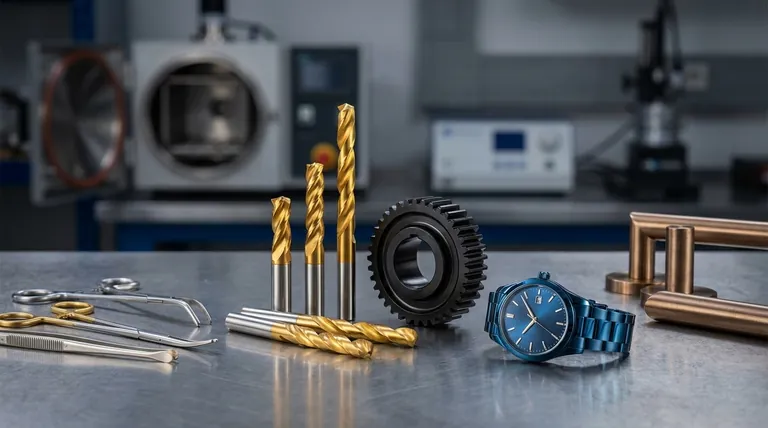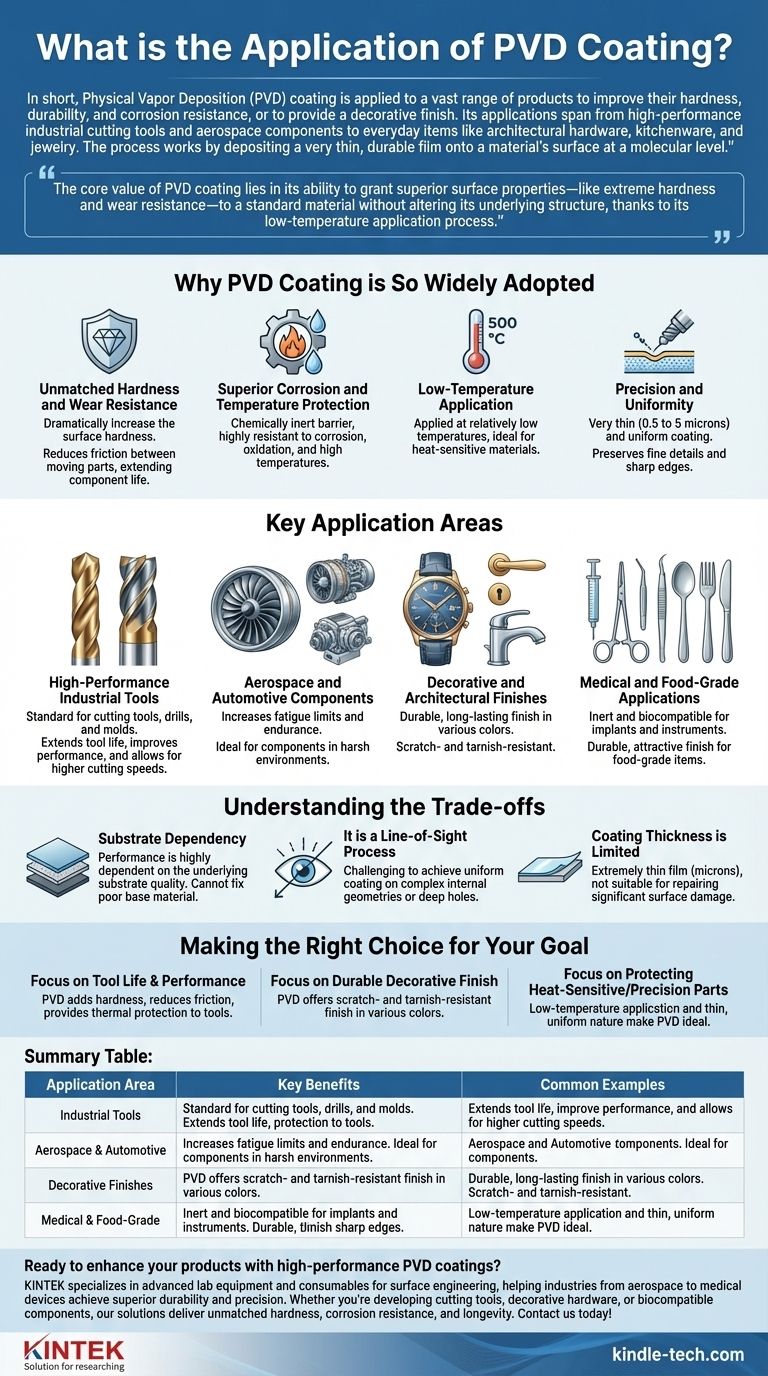In short, Physical Vapor Deposition (PVD) coating is applied to a vast range of products to improve their hardness, durability, and corrosion resistance, or to provide a decorative finish. Its applications span from high-performance industrial cutting tools and aerospace components to everyday items like architectural hardware, kitchenware, and jewelry. The process works by depositing a very thin, durable film onto a material's surface at a molecular level.
The core value of PVD coating lies in its ability to grant superior surface properties—like extreme hardness and wear resistance—to a standard material without altering its underlying structure, thanks to its low-temperature application process.

Why PVD Coating is So Widely Adopted
The versatility of PVD comes from a unique combination of process advantages and the resulting high-performance characteristics of the finish. It solves the problem of needing a material to be both structurally sound and have an exceptionally durable surface.
Unmatched Hardness and Wear Resistance
PVD coatings dramatically increase the surface hardness of the base material. This creates a finish that is highly resistant to scratches and general wear.
This enhanced hardness also reduces friction between moving parts, which is critical for extending the life of components like cutting tools and engine parts.
Superior Corrosion and Temperature Protection
The coating creates a chemically inert barrier on the surface, making it highly resistant to corrosion, oxidation, and high temperatures.
This protective layer is essential for parts used in harsh environments, from industrial manufacturing to aerospace applications.
Low-Temperature Application
Unlike other coating processes like Chemical Vapor Deposition (CVD), PVD is applied at relatively low temperatures (around 500 °C).
This makes it ideal for coating heat-sensitive materials that would be damaged or warped by higher-temperature processes.
Precision and Uniformity
The PVD process results in a very thin (typically 0.5 to 5 microns) and uniform coating.
This preserves the fine details and sharp edges of the original part, which is crucial for items like drill bits, milling cutters, and medical instruments. The thinness also reduces cutting force and heat during operation.
Key Application Areas
These fundamental benefits translate directly into a broad set of practical, real-world applications across numerous industries.
High-Performance Industrial Tools
PVD is a standard for coating cutting tools, drills, and molds. The hardness and low friction extend tool life, improve performance, and allow for higher cutting speeds.
The coating's compressive stress helps prevent micro-cracks from forming and expanding, making it perfect for interrupted cutting processes like milling.
Aerospace and Automotive Components
In aerospace, coatings like Titanium Nitride (TiN) are applied to alloys to increase fatigue limits and endurance.
The combination of wear resistance, corrosion protection, and durability makes PVD ideal for critical components that must perform reliably under extreme stress.
Decorative and Architectural Finishes
PVD provides a durable, long-lasting finish in a wide variety of colors and textures for consumer products.
It is frequently used on stainless steel for architectural hardware, plumbing fixtures, watches, and jewelry, offering an aesthetic look that doesn't tarnish or scratch easily.
Medical and Food-Grade Applications
Because the process is environmentally friendly and the resulting coatings are inert and biocompatible, PVD is used for medical implants and surgical instruments.
It is also used to coat food-grade items like stainless steel cutlery, bowls, and coffee cups, providing a durable and attractive finish.
Understanding the Trade-offs
While powerful, PVD is not a universal solution. Understanding its limitations is key to applying it correctly.
Substrate Dependency
The final performance of the coated part is highly dependent on the underlying substrate. A PVD coating cannot fix a poor-quality base material; it only enhances the properties of a well-prepared surface.
For example, the coating's adhesion and overall durability rely on the cleanliness and chemistry of the material it is being applied to, such as stainless steel, titanium, or nickel alloys.
It is a Line-of-Sight Process
The PVD process generally requires a direct "line of sight" between the coating source and the surface being coated.
This can make it challenging to achieve a perfectly uniform coating on parts with complex internal geometries or deep, narrow holes. Proper racking and rotation within the chamber are critical to mitigate this.
Coating Thickness is Limited
PVD creates an extremely thin film. While this is an advantage for preserving sharp edges, it means it is not suitable for applications requiring a thick buildup to repair significant surface damage or alter dimensions.
Making the Right Choice for Your Goal
To determine if PVD is the correct solution, consider your primary objective.
- If your primary focus is maximizing tool life and performance: PVD is an industry standard for adding hardness, reducing friction, and providing thermal protection to cutting tools and industrial components.
- If your primary focus is a durable decorative finish: PVD offers a superior alternative to traditional plating for consumer goods, providing a scratch- and tarnish-resistant finish in various colors.
- If your primary focus is protecting heat-sensitive or precision parts: The low-temperature application and thin, uniform nature of PVD make it the ideal choice for coating components that cannot tolerate thermal stress or dimensional changes.
Ultimately, PVD coating empowers you to engineer a material's surface properties separately from its core mechanical characteristics.
Summary Table:
| Application Area | Key Benefits | Common Examples |
|---|---|---|
| Industrial Tools | Extreme hardness, wear resistance, reduced friction | Cutting tools, drills, molds |
| Aerospace & Automotive | Corrosion protection, high-temperature resistance, fatigue limit increase | Engine components, turbine blades |
| Decorative Finishes | Scratch resistance, tarnish-free, variety of colors | Watches, architectural hardware, jewelry |
| Medical & Food-Grade | Biocompatibility, inert coating, durability | Surgical instruments, implants, food-grade cutlery |
Ready to enhance your products with high-performance PVD coatings? KINTEK specializes in advanced lab equipment and consumables for surface engineering, helping industries from aerospace to medical devices achieve superior durability and precision. Whether you're developing cutting tools, decorative hardware, or biocompatible components, our solutions deliver unmatched hardness, corrosion resistance, and longevity. Contact us today to discuss how PVD coating can transform your materials and meet your specific application needs!
Visual Guide

Related Products
- Custom CVD Diamond Coating for Lab Applications
- Split Chamber CVD Tube Furnace with Vacuum Station Chemical Vapor Deposition System Equipment Machine
- 1400℃ Controlled Atmosphere Furnace with Nitrogen and Inert Atmosphere
- Electric Heated Hydraulic Vacuum Heat Press for Lab
- Vacuum Dental Porcelain Sintering Furnace
People Also Ask
- What are diamond coated films? Enhance Materials with Super-Hard, Transparent Layers
- What is CVD diamond coating? Grow a Super-Hard, High-Performance Diamond Layer
- Is diamond coating worth it? Maximize Component Life and Performance
- How are tools coated with diamond? Achieve Superior Hardness and Low Friction for Your Tools
- Is diamond coating permanent? The Truth About Its Long-Lasting Durability



















